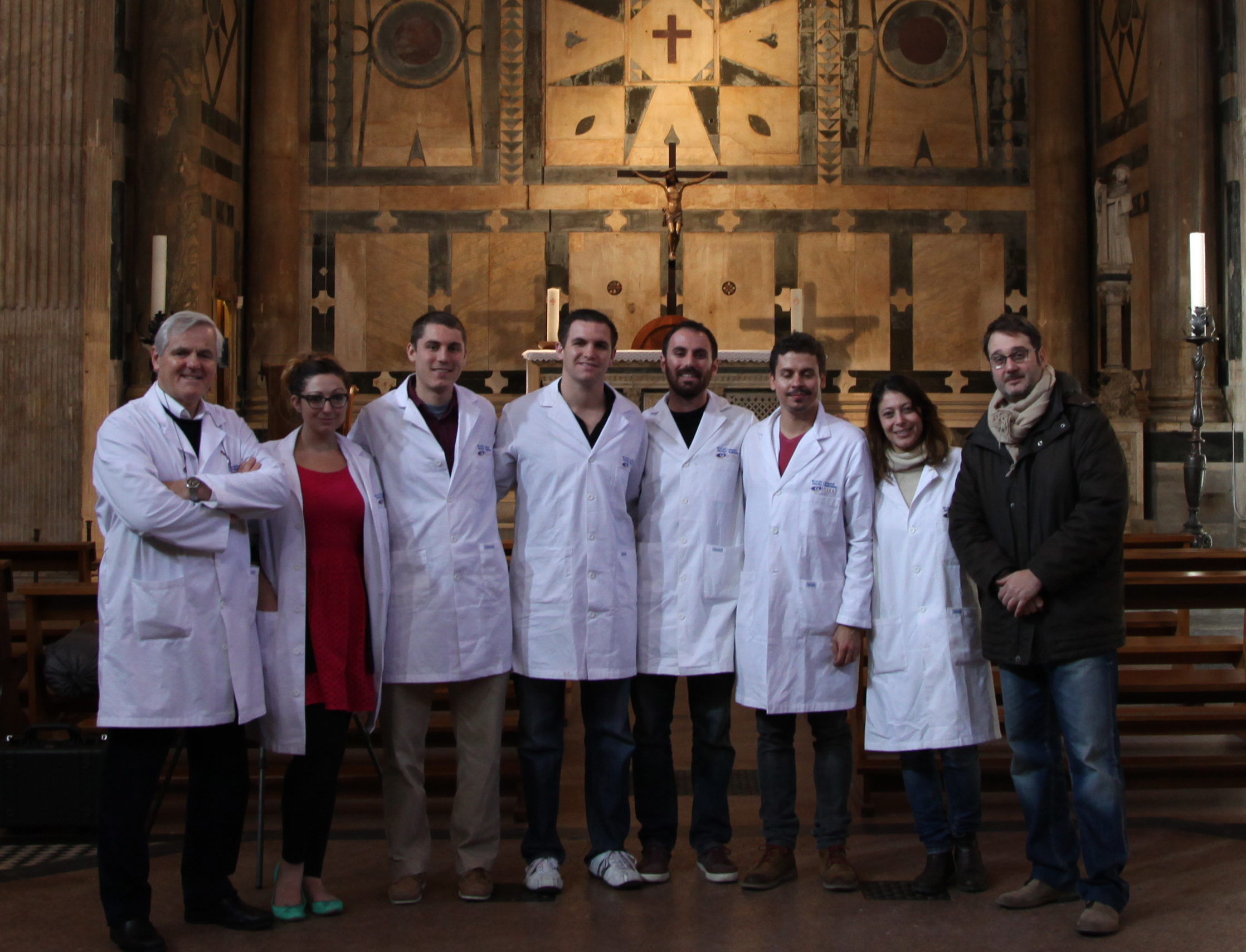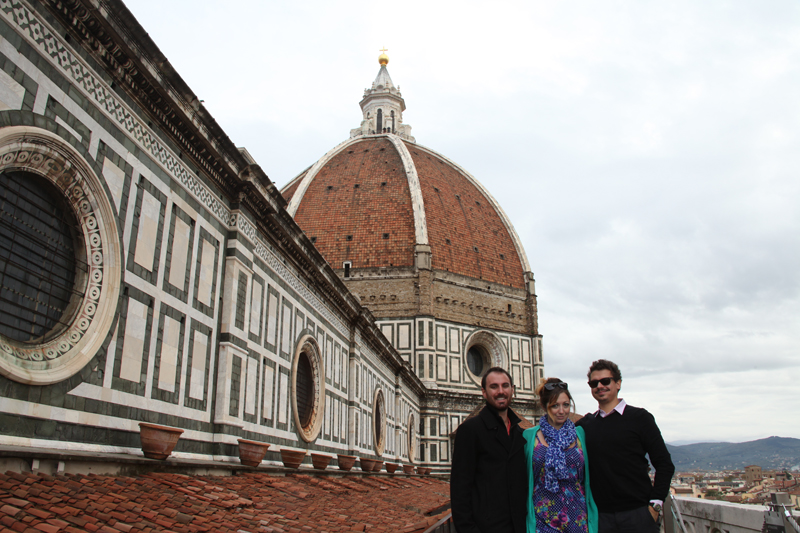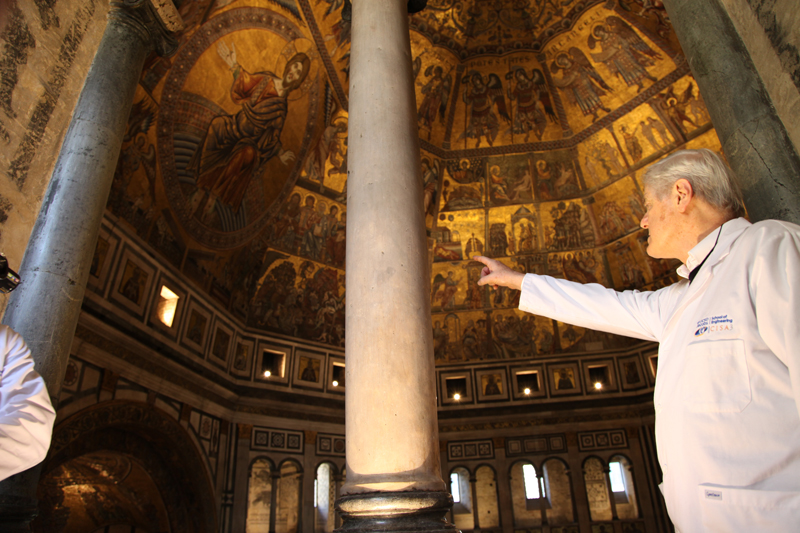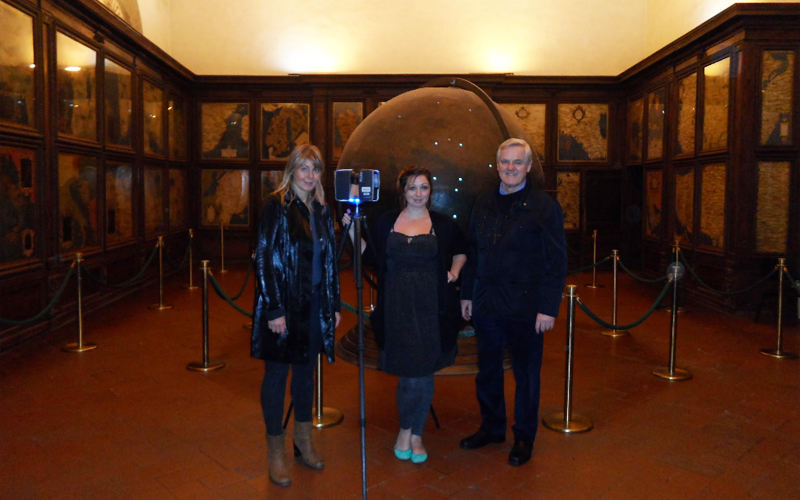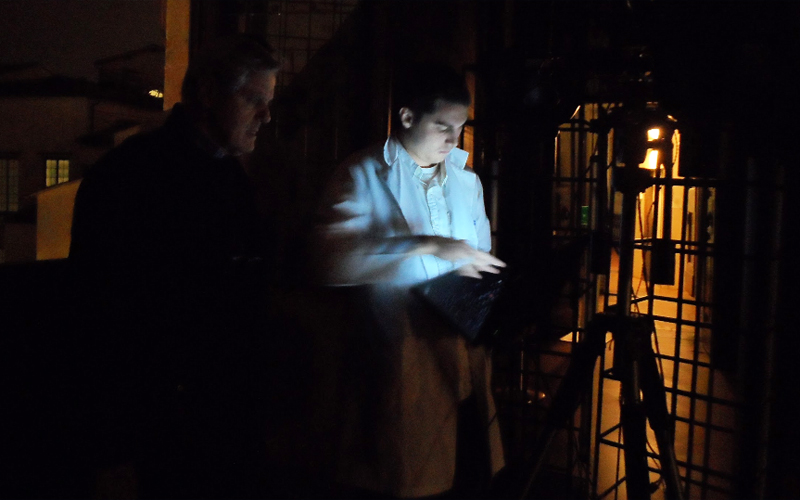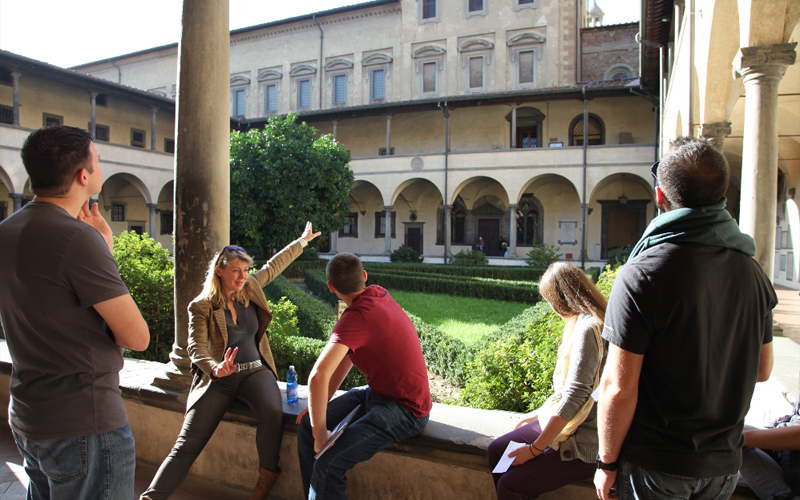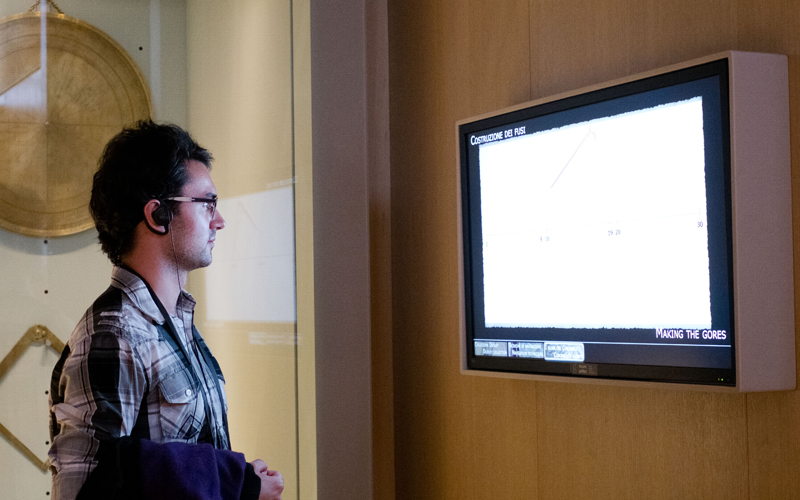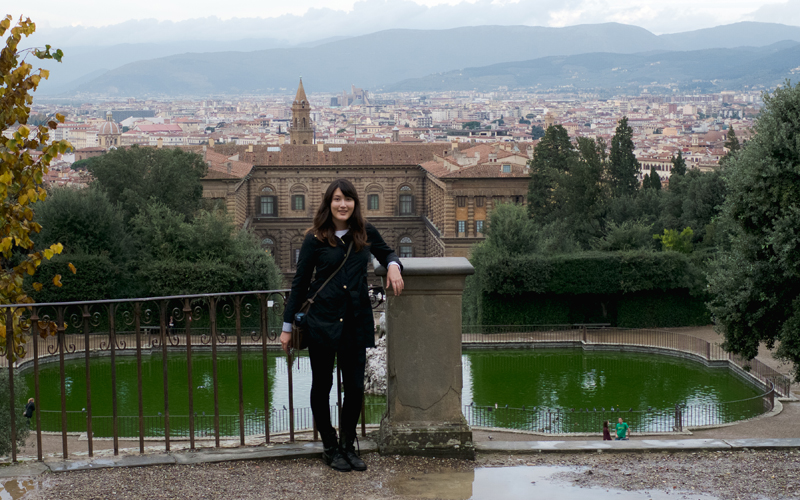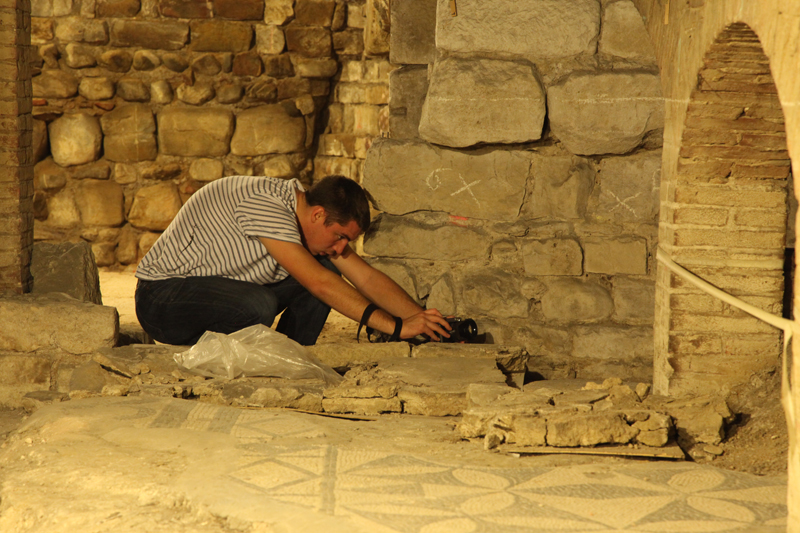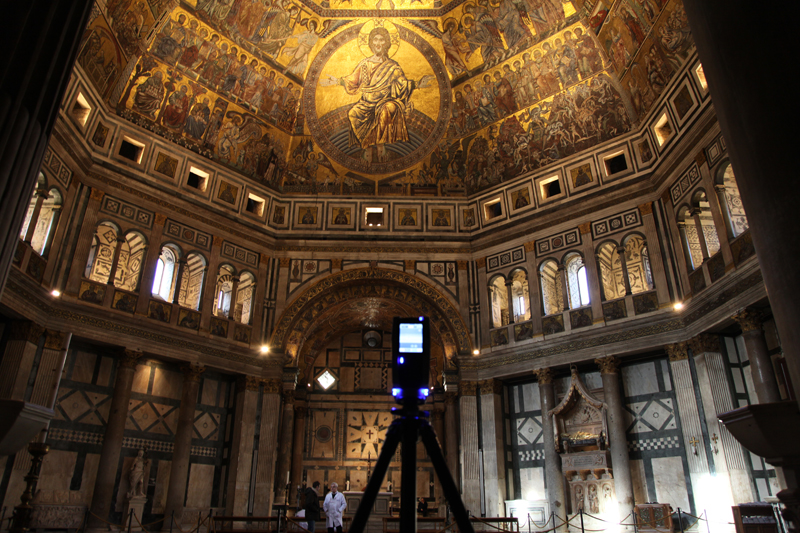News Release
UC San Diego Students Look Back on Fall Field Expedition in Florence
San Diego, Calif., Jan. 16, 2014 -- When they weren’t traveling to give research presentations or participate in archaeological digs and engineering collaborations in southern Italy or Greece, six graduate students from the University of California, San Diego spent most of the Fall 2013 quarter in Florence through late November. [Note: Much of the data gathered in Florence will be on view at the next Open Lab Night of the Center of Interdisciplinary Science for Art, Architecture and Archaeology (CISA3). The Open Lab Night takes place Feb. 20 from 5-7 p.m., and the public is invited to meet with the students and researchers, and to view results on the center's new WAVE curved 3D display system.]
|
The students came from different academic backgrounds. John Mangan, Vid Petrovic and David Vanoni are Ph.D. students in Computer Science and Engineering. Mike Hess is in Structural Engineering, and Ashley M. Richter from Anthropological Archaeology. In Florence, they met up with Samantha Stout , a Ph.D. student in Materials Science and Engineering, who is spending the entire year in Florence.
In addition, two 2013 UC San Diego graduates in Cognitive Science – James M. Darling and Melissa Wedeen – spent two weeks in Florence in November, building on their prior involvement in the CISA3 Undergraduate Research Innovation Internship (CURII) program.
All of the students had one thing in common: they were all involved in CISA3, based in UCSD’s Qualcomm Institute. The graduate students were also part of the interdisciplinary NSF IGERT program in engineering for cultural heritage diagnostics, led by CISA3 Director Falko Kuester. On the ground, however, it was CISA3’s emeritus director, Maurizio Seracini, who oversaw the program and paved the way for the UCSD students to work with some of the most important art works and historic buildings of the Renaissance and earlier.
“The CISA3 field season in Florence gives students the opportunity to interact with truly world-class works of art and historic structures, all in one place -- an unprecedented concentration of cultural heritage unlike anywhere in the world,” said Seracini, who r acilitated the group research activities in Florence. “The graduate students get to continue work on their own Ph.D. research projects, but they also came together in a cohesive, interdisciplinary team to undertake joint projects at various sites around Florence.”
L’Opera del Duomo
Those sites include L’Opera di Santa Maria del Fiore, known colloquially as L’Opera del Duomo (OPA), a complex that includes the Grand Museum, the cathedral with Brunelleschi’s Dome, Giotto’s Bell Tower, the Crypt of Santa Reparata, and the Baptistery of Saint John. “The OPA organization is responsible for any conservation or renovations at the site, and OPA signed a five-year Memorandum of Understanding (MoU) to work with CISA3 researchers,” said CISA3’s Kuester, who traveled to Florence to initiate the agreement and launch the field season in collaboration with Seracini. CISA3 and its IGERT students joined OPA’s interdisciplinary team trying to establish a chronology of construction for the Baptistery of Saint John, one of the oldest buildings in Florence.
|
The evolution of the site from its Roman origins is shrouded in mystery. “Significant research has been done by dedicated scholars, but they had limited tools to correlate the totality of that information and make sense of it,” noted Kuester. “That’s where CISA3 has something to offer with our concept of digital, annotated scaffolds for data.”
Working with Florence-based Seracini, the team of CISA3 grad students undertook an ambitious program of imaging and laser scanning. They were given access to the interior of the hexagonal building three days very early in the morning in order get some of the work done before the building opened to tourists, and a further day late at night.
Late night also turned out to be the best time to image the exterior of the Baptistery, when the crowds in the Piazza were more manageable. A major obstacle in imaging the exterior was that the distinctive roof could not be recorded from ground level in the piazza. Seracini appealed to OPA officials, who then gave the UC San Diego team a prize location from which to scan and image the Baptistery’s roof: the front-facing roof of the Duomo itself (see photo). “Getting access to the roof of the Duomo allowed us to look down on the roof of the Florentine Baptistery,” recalled archaeology Ph.D. student Ashley Richter. “It allowed us to collect as much information as possible before the winter, when they will be putting up scaffolding around the building ahead of beginning a conservation project on the roof itself.”
|
With the MoU in place between OPA and UCSD, CISA3 has been invited to join the Italian conservators on the scaffolding, which will allow the CISA3 team to do additional close-range imaging and structural evaluation.
The work on the Florentine Baptistery allowed the CISA3 students to gather a massive trove of image data, acquired via terrestrial laser scanning, thermography, high-resolution photogrammetry (including structure from motion), and stereoscopic (3D) imaging. In addition, they undertook multispectral imaging of both the interior and exterior of the building, emphasizing spaces to which the public has no access. “There are three floors up there that no one ever sees or even realizes exist, since only one level of balcony is visible from the ground,” said structural engineering Ph.D. student Mike Hess. “We also had access to the subterranean Roman archaeological site below the altar.”
“Most people don’t realize that there are these archaeological layers beneath the cityscape they can see, and bringing these seemingly invisible parts of the city’s history to light changes and enhances the way people view the past as part of their cultural present,” added Ashley Richter. “These levels also need to be considered as part of the context of the popular monuments – as the literal and metaphorical foundations upon which the city was built, they not only have cultural meaning, but they strongly affect the conservation health of the monuments above them.”
|
Palazzo Vecchio
On previous expeditions, CISA3 researchers compiled a highly accurate 3D computer model of the Great Hall (also known as the Hall of the 500) in Florence’s Palazzo Vecchio inside and out. The model was used as a reference during the search for a Leonardo da Vinci masterpiece mural, “The Battle of Anghiari.” During the current expedition, Seracini oversaw the acquisition of a point-cloud model of the exterior of the entire Palazzo Vecchio. “We did all of the exterior laser scanning late at night,” said Ph.D. student John Mangan, who is researching techniques for cloud-centric data processing and communication of rich cultural heritage data collections “That’s when the Piazza della Signoria and surrounding streets were at their emptiest.”
City officials also invited the CISA3 team to expand the number of rooms and spaces that can eventually be integrated into a single, overall 3D model of the entire Palazzo Vecchio. These included the Sala degli Elementi (Room of the Elements) and surrounding hallways, where the UCSD team emphasized collection of diagnostic information to support a conservation plan that is needed to deal with the room’s warping floor and cracks in walls. The work in the Sala degli Elementi included thermography, laser scanning, high-resolution photography, and stereoscopic photography.
Previous work conducted by CISA3 structural engineering Ph.D. students Richard Wood and Christine Wittich in collaboration with professor Tara Hutchinson and Falko Kuester in the 2011 CISA3 field season in Florence collected an earlier model of the Sala degli Elementi which now serves as a temporal representation of the space. Multiple models collected over time can be used for long-term analysis of the site deformation and assist with building effective and sustainable conservation plans to keep the building sound. The temporal data sets are part of a CISA3 initiative to engineer analytical systems, which can capture time-varying information in massive data sets. Computer Science and Engineering Ph.D. student David Srour was on site, investigating point-based data representation strategies, enabling the synthesis, visualization and intuitive exploration of the collected data.
|
“We extended our laser scanning, high-resolution imaging, and multispectral imaging survey to include other rooms not previously surveyed by CISA3 on the far side of Palazzo Vecchio,” noted Ph.D. student Vid Petrovic. “The main emphasis was on the Hall of Geographical Maps and surrounding spaces, where the central globe – the Mappus Mundi – is unreadable.” For Petrovic, the field expedition provided a one-on-a-kind living laboratory for the evaluation, application and refinement of rapid “big-data” visualization techniques, allowing billions of data points to be synthesized and visually explored on the fly, informing the work conducted by the highly interdisciplinary CISA3 team. By taking research from the lab into the “the wild,” CISA3 students gain important experience, going from theory to practice while working with domain experts solving real-world problems.”
|
Added fellow computer science Ph.D. student David Vanoni: “We are now looking into whether non-intrusive imaging methods can reveal what is on the map and how we can make that information available to the touring public. Making these closed off spaces and data part of the public experience of sites and artifacts is one of the driving cultural heritage problems for which we are engineering solutions.” Vanoni’s research focuses on augmented reality and human-computer interaction techniques that allow researchers and the public alike to literally hold vast amounts of cultural heritage information directly in their palm in the form of a tablet or smartphone, used to superimpose computer-generated information onto the real world. These techniques allow users to see what cannot be seen and artifacts to be “touched,” digitally at least. Discussions are underway on an MoU with the Palazzo Vecchio to expand this and future projects related to technology and cultural heritage conservation.
ISI Florence
A third round of projects were carried out in collaboration with the Studio Architetto Bracciali and the International Studies Institute (ISI) Florence. UCSD materials science and engineering Ph.D. student Samantha Stout, who has been part of CISA3’s IGERT project from the beginning, was responsible for coordinating the CISA3 team’s involvement in two projects: one involved the historic Palazzo Rucellai (where ISI Florence is based), and the other was the Torre di Baldovinetti. In the case of Palazzo Rucellai, the data collected by CISA3 is a key step in the application of our structural survey methodologies for time-monitoring, since there exist several other sets of 3D point cloud data for the Palazzo collected surrounding the most recent restorations carried out between 2001-2005. For the latter, the CISA3 team aimed to collect visual information for structural evaluation before a conservation plan is developed by Architetto Simonetta Bracciali in charge of safeguarding the historic tower.
|
“These projects gave both myself and the other students a look into how smaller projects, in the case where a historical piece of architecture is under private ownership, are managed from an engineering and conservation perspective,” said Stout. “Understanding the sorts of questions posed by the architect and her team gave the CISA3 team real-world experience outside of the typical university setting.”
Florence also turned into a living classroom. Art historian Katharina Giraldi-Haller offered an in-depth course that was mandatory for all the CISA3 graduate students while in Florence. It focused on the interface between science, technology, and the development of art and architecture in the city, with an emphasis on the interdisciplinary, collaborative nature of Renaissance artisans and workshops that produced the monuments and artifacts that CISA3 studies in Florence.
“The Renaissance, where the engineer and artist are one and the same, is needed in the modern world,” argued CISA3 DIrectorFalko Kuester. “That is precisely what the center is trying to do by exposing our students and researchers to Florence’s vast cultural heritage, and getting them to work side-by-side with colleagues from other disciplines, at a point in their Ph.D. careers when most students are singularly focused on their own research.”
|
Museum Technology Survey
In tandem with planning for the CISA3 Florence expedition, UC San Diego students majoring in cognitive science spent two weeks in Florence to undertake a museum technology survey. James Darling (BA ’13), who also majored in anthropological archaeology, and Melissa Wedeen (BA ’13), who did a concentration in human-computer interaction, were both part of the CISA3 Undergraduate Research Innovation Initiative (CURII). They joined the CISA3 team in Florence from Nov. 7-20. “Our goal was to investigate how museums are using technology to disseminate knowledge and help visitors to better engage with their exhibits,” said Darling.”There was no central repository of information on technologies used in local museums, but by the end of our expedition, we had managed to survey over 29 museums and countless other churches and cultural heritage sites.”
The two researchers found that audio guides and TVs recycling video clips were the most commonly employed technologies in Florentine museums. In a few museums, however, visitors had access to tablet-based video guides, touch screens, and even mobile apps. “The video guides were mainly used to combine audio tours with better visuals for tourists as part of a larger museum tour,” explained Wedeen. “The touch screens had a much more interactive element within their exhibit, but their content was restricted to the one room of the exhibit in which they were located.”
|
Indeed, the recent UCSD grads found that most of the museums made no attempt to explain the art pieces on display – not in Italian, and not in English. In the few museums where mobile apps were available, they typically only contained textual information, and even then, only about the most important works on display (making little use of the visual and audio capabilities of the smartphones or tablets running the apps).
Darling and Wedeen interviewed Valentina Zucchi, Scientific Manager of the Education Department for Museums, who talked about drawbacks and successes in implementing new technologies to benefit visitors to Florence’s many museums, especially in connection with the two museums using tablets (the Palazzo Vecchio, and the Brancacci Chapel). According to Zucchi, several other tablet deployments are in the works, including at the Basilica di Santa Maria Novella, and a tablet-based tour for children visiting the Palazzo Vecchio. Zucchi also provided contacts for follow-up interviews to be carried out after their return to the U.S. Darling is now a Qualcomm Institute staffer working for CISA3, where he is continuing work on the project while also becoming involved with other CISA3 experts who are working on new technologies that could one day be deployed extensively to explain the unparalleled wealth of art in Florentine galleries, churches and museums.
|
Field Expeditions
The fundamental goal of CISA3’s field expeditions is to bring the science and technology – such as David Vanoni’s ARtifact augmented-reality research, and Vid Petrovic’s layerable gigapixel synthesis and visualization research – into the field. There, UCSD graduate students can interact in person with museums and other guardians of cultural heritage, creating a dialogue between organizations with technology needs, and engineers who can fulfill those needs.
Previous field seasons in 2011 and 2012 took the IGERT students to archaeological sites throughout southern Jordan as part of the UCSD Middle Eastern Archaeology Field School, and the Edom Lowlands Regional Archaeology Project (ELRAP). Field seasons in 2008 and 2011 also focused on work in Florence at the Palazzo Vecchio and the Palazzo Medici Riccardi, as well as on analysis of paintings and sculptures by Renaissance masters throughout the city. The first part of the 2013 field season was similarly spent engaging with cultural heritage groups in Greece and Calabria.
|
Florence is a unique field site because of its rich cultural heritage, and with the team having returned to San Diego, a significant part of the work is just beginning. It will involve collocating all of the data captured, which must be processed, cross-referenced through vast data infrastructures, and visualized in 2D, 3D, augmented (AR) and other ‘realities’ in order for scientists and the public at large to make sense of the massive data sets. This data is driving our interdisciplinary research and inspiring many new research projects being conducted at the fundamental domain-science level. “Ultimately, the information gathered in Florence, it is hoped, will lead to a better understanding of art works and historic sites,” said CISA3 Director Falko Kuester, adding that industry partners such as Leica-Geosystems, Qualcomm, and Intel, have allowed CISA3 teams to take a well-equipped, mobile laboratory into the field. ”Eventually this type of research will lead to better conservation and safeguarding of the past for the benefit of future generations.”
By Doug Ramsey, with reporting from Ashley M. Richter, James M. Darling and other CISA3 researchers
Media Contacts
Doug Ramsey
Jacobs School of Engineering
858-822-5825
dramsey@ucsd.edu
